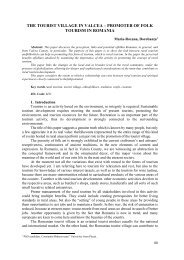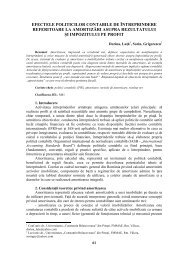equivalence versus non-equivalence in economic translation
equivalence versus non-equivalence in economic translation
equivalence versus non-equivalence in economic translation
You also want an ePaper? Increase the reach of your titles
YUMPU automatically turns print PDFs into web optimized ePapers that Google loves.
Although she attempts to outl<strong>in</strong>e some of the most common types of <strong>non</strong>-<strong>equivalence</strong>which often pose difficulties for the translator and some attested strategies for deal<strong>in</strong>g withthem, Baker admits that: “It is virtually impossible to offer absolute guidel<strong>in</strong>es for deal<strong>in</strong>gwith the various types of <strong>non</strong> <strong>equivalence</strong> which exist among languages” (1992/2006: 17).Nevertheless, a translator needs to be aware of some strategies which may be used to dealwith <strong>non</strong>-<strong>equivalence</strong> <strong>in</strong> certa<strong>in</strong> contexts.2.1. Lexical Sets and Semantic Fields <strong>in</strong> Economic TranslationIf a translator understands the concepts of semantic fields and lexical sets, he/she canappreciate the value that a word has <strong>in</strong> a given system and develop strategies for deal<strong>in</strong>gwith <strong>non</strong>-<strong>equivalence</strong> (ibid.: 19). The difference <strong>in</strong> the structure of semantic fields <strong>in</strong> theSL and TL allows a translator to assess the value of a given item <strong>in</strong> a lexical set. Know<strong>in</strong>gwhat other items are available <strong>in</strong> a lexical set and how they contrast with the item chosenby a certa<strong>in</strong> author, you can appreciate the significance of the author’s choice.In addition, the hierarchical arrangement of semantic fields could help translators toface semantic gaps <strong>in</strong> the TL “by modify<strong>in</strong>g a superord<strong>in</strong>ate word or by means ofcircumlocutions based on modify<strong>in</strong>g superord<strong>in</strong>ates” (ibid.: 20).Whereas semantic fields are abstract concepts, the actual words and expressionsunder each field are sometimes called lexical sets (ibid.: 18). Each semantic field hasseveral sub-divisions or lexical sets under it and each sub-division has further sub-divisionsand lexical sets. For example, the field of change <strong>in</strong> <strong>economic</strong> English has more subdivisions<strong>in</strong>clud<strong>in</strong>g verbs show<strong>in</strong>g an upward trend (bounce back; climb; escalate; go up;grow; improve; <strong>in</strong>crease; leap; jump; pick up; rally; recover; rise; rocket; shoot up; soar;surge; take off), verbs show<strong>in</strong>g a downward trend (come down; crash; decl<strong>in</strong>e; decrease;dip; drop; fall; fall off; go down; plummet; plunge; shr<strong>in</strong>k; slide; slump), verbs show<strong>in</strong>g nochange (flatten out; hold steady; level off; level out; settle down; stabilize; stagnate; standaround; stick at around; stay steady) and verbs show<strong>in</strong>g fluctuation (change; fluctuate;oscillate). A variety of general or more specific verbs are used to express the idea ofchange and they range from the <strong>in</strong>formal to the formal register ask<strong>in</strong>g for similarcounterparts when translated <strong>in</strong>to Romanian. The problem is that the more detailed asemantic field is <strong>in</strong> a given language, the more different it is likely to be from relatedsemantic fields <strong>in</strong> other languages. There generally tends to be more agreement amonglanguages on the larger head<strong>in</strong>gs of semantic fields and less agreement as the sub-fieldsbecome more f<strong>in</strong>ely differentiated.2.2. Non-<strong>equivalence</strong> and Translation Strategies of Economic TextsNon-<strong>equivalence</strong> at the word level means that the TL has no direct equivalent for aword which occurs <strong>in</strong> the ST. Baker (1992/2006: 21-26) identifies the follow<strong>in</strong>g commontypes of <strong>non</strong>-<strong>equivalence</strong> at word level:a) Culture-specific concepts – are totally unknown <strong>in</strong> the target culture (TC)because they reflect a reality specific to the source culture (SC): aff<strong>in</strong>ity card – “card decredit, emis în Statele Unite, pentru un anumit grup (aff<strong>in</strong>ity group), precum membrii unuiclub, colegiu etc.” (Dic ionar de bus<strong>in</strong>ess englez-român 2009: 23); <strong>in</strong>land bill – “cambiecare este emis i pl tit în Regatul Unit al Marii Britanii” (ibid.: 349); moonlight<strong>in</strong>g – “aavea dou slujbe, una cu norm întreag , pe timpul zilei, i una cu jum tate de norm (parttime)seara” (ibid.: 450); primary earn<strong>in</strong>gs per share – “în SUA, reprez<strong>in</strong>t un calculdest<strong>in</strong>at evalu rii performan elor companiilor cu <strong>in</strong>strumente complexe” (ibid.: 538); primerate – “rata dobânzii, la care b ncile americane împrumut bani debitorilor de primacategorie (base rate în Marea Britanie)” (ibid.: 539). Gradually, some of these terms maybecome part of the reality <strong>in</strong> the TC and they could be borrowed and used as loans.77







